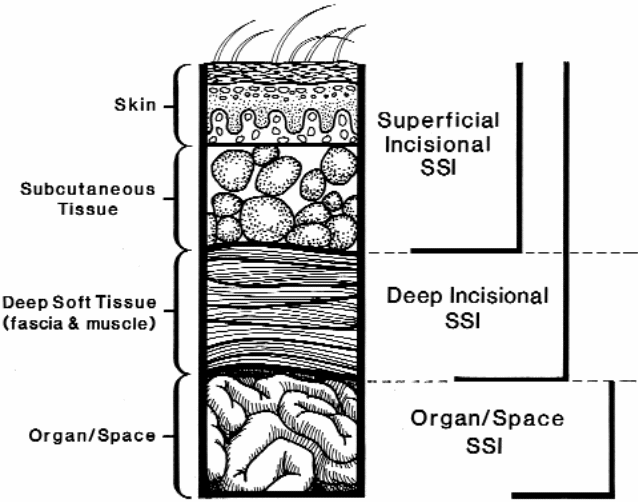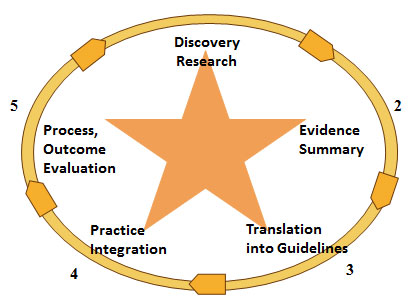Heart surgery continues to be a salient operative procedure regardless of current technologies in coronary revascularization. At least 600,000 individuals undergo open heart surgery in the United States, every year (Haycock, 2005). Post surgery infections, though rare after open heart surgery, can have debilitating effects. However, among the nosocomial infections, surgical site infections (SSIs) occur more frequently than other types of infections. These SSIs occur within a span of 30 days after surgery. The infections can either be superficial, deep incisional infections or infections that affect organs or body spaces as shown in figure 1 below (Owens & Stoessel, 2008). Postsurgical wound care management is crucial in the prevention of postsurgical infections; hence, this paper aims at presenting a design of practice to prevent postsurgical infections.

Evidence-Based Practice
Discovery Research
Reference to the Acer Star Model that is shown below (Cooper, 2011), generating knowledge through literature search to identify ways of improving health care delivery with regard to postsurgical infection is the first step towards practice change. The knowledge that this paper seeks to discover is on surgical site infections, and a summary of evidence is obtained from various peer-reviewed articles.

Acer Star Model.
Evidence Summary
Post-surgical infections may stem from pre-surgery preparations; hence, the entire surgical procedure of handling the surgical site should be cautiously carried out. The CDC guidelines (Mangram, Horan, Pearson, Silver, & Jarvis, 1999) should be followed to the letter, but it is unclear whether these guidelines are cautiously and obediently followed. The facts summarized in this paper have been obtained from high quality reviews and research studies that have adopted experimental research designs.
Before Surgery
Preoperative patient and skin preparations
The first thing is to ensure that the patient’s general health condition is good, and he or she has no local infections. The patient should maintain a healthy nutritional status through healthy eating and should not use smoke and alcohol. Secondly, if need be, hair should be removed just before the operation by clipping and not by using the traditional shaving method with razors. The skin around the incision site should be thoroughly washed before disinfecting the incision area with chlorhexadine in alcohol (Owens & Stoessel, 2008). In the recent past, research indicates that 2% chlorhexidine in alcohol is very effective in reducing surgical site infections compared to the use of povidone iodide (Cabrera, 2010). It is, however, important to note that alcohol solutions are not ideal for damaged skin and neonates.
Administration of prophylactic antibiotics and monitoring
Prophylactic antibiotics should be administered to help attain bactericidal concentrations in the blood and tissues before the first incision. Monitoring of these bactericidal concentrations of the drug should be done throughout the surgery, and some hours after the surgery. The aim of giving this antibiotic is to help the patient cope with intraoperative contamination. The type of antibiotic is dependent on the pathogens associated with a particular procedure. It is not advisable to use vacomycin as a routine prophylaxis.
Control of blood glucose
Intensive insulin therapy is necessary at this point because hyperglycemia and insulin resistance are a major problem for severely sick patients, and especially those with a history of diabetes.
Personnel
Infected personnel should be treated to avoid cross-contamination, and they should perform surgical scrubs before putting on surgical wear.
Perioperative strategies
Surgical technique
A good surgical technique is that which ensures haemostatis is maintained, and devitalized tissue, foreign bodies and dead space are removed (Owens & Stoessel, 2008). The room where the operation is being conducted should be as sterile as possible; hence, the use of protective wears, such as, gloves, gowns, facemasks and sterile drapes. Flash sterilization is applied in cases where instruments are required for immediate use, such as when they unwittingly fall. A microbial sealant is recommended for use due to the presumption that endogenous bacteria remain despite the fact that proper procedures are followed. Various studies have shown that the microbial seal, a cyanoacrylate-based antimicrobial sealant, is associated with reduced surgical site infections (Dohmen, 2011).
Post Operation
Wound care management
The first 48 hours are very critical, and the wound should be protected using sterile dressing. However, there is usually a lot of variation in how wound care management is conducted after these hours due to lack of assented evidence. Therefore, this design will aim at gathering facts from different researches that indicate successful postsurgical results. After this time (48 hours), hand hygiene using alcohol has been associated with better results compared to the use of soap and water. Emphasis on alcohol-based hand rubs is due to the inconvenience of hand washing and the high non-adherence rate. Healthcare workers will only wash their hands when visibly soiled; thus as a means of infection control, alcohol-based rubs should be available always. Surveillance is also an important intervention offered after the first 48 hours in the case of closed surgery.
There is a lack of scientific evidence on effective strategies that could help to reduce post surgery infections. As a result of this, it is important for the health care team in the telemetry unit to deliberate about the existing CDC guidelines, and whether the unit abides by them, any gaps that need improvement and solutions to improve management of wound care at this point. The patient is educated on how to take care of the wound, and especially when being discharged. Hygiene is emphasized at this point since it is the only way to avoid infections.
Translation into Guidelines
This stage will entail identification of ways that will be used to relay information to the rest of the staff, and what will be required to do this. I will also identify the equipment that I know will be required to effect changes. I will be required to justify the need for these changes. I will develop a plan on how to introduce these changes without overwhelming the hospital system; thus, I will select the staff that will be trained. These will be the health care workers who are very knowledge and with adequate experience in the telemetry unit, so that cost-effectiveness is ensured while training.
Practice Integration
Train the Staff
Reduction of post surgical site infection in the telemetry unit will only be possible if the staff is well-informed; hence, training is imperative. The staff working in the telemetry unit will be educated on the evidence-based practices that have had a positive impact preventing postsurgical infections on the surgical site. The staff will be trained on all the aforementioned procedures, and caution will be emphasized in post surgery wound management where evidence is limited, and the guidelines seem to be the only source of reference. The health care workers selected for training will also present their views on additional tools and resources they feel are required in implementing the new changes. The health care providers will be cautioned about the usage of wrong terminologies to avoid confusion. Haycock’s et al. (2005) review indicates that despite a 100% clipping compliance, health workers used clipping and shaving interchangeably. In addition, the training will entail a review of the nursing code of ethics to enhance performance and cooperation among the staff. Due to limited evidence on reduction of surgical site infections after surgery, the CDC recommends documentation of both direct and indirect approaches to help obtain information on the occurrence of SSIs in relation to specific procedures (Mangram, Horan, Pearson, Silver, & Jarvis, 1999).
Soliciting Resources from the Management
I will have a meeting with the management of the hospital: the CEO, the director and the manager of the cardiac surgery department. During the meeting, I will make a presentation about post surgery site infections: occurrence in the telemetry unit, findings, prevailing gaps in the telemetry unit, and how these gaps can be addressed. Convincing the management team about the need for changes is very important because it holds the key to making the change in practice a reality. I will present the already outlined plan to guide in the implementation of changes and planning of finances.
Process, Outcome and Evaluation
Once the management agrees about the developed planned on how to improve management of post surgical site infections, the necessary equipment will be bought, and only trained staff will operate in the unit. In addition, the policy regarding surgery procedures in the telemetry unit will be modified. The novel procedures will be executed with caution and after one month, there will be an assessment of the trend in the occurrence of post surgical site infections.
References
Cabrera, R. H. (2010). Prevention of surgical-site infection, using a modified bundle. Rev esp cir ortop traumatol., 54(5), 265-271.
Cooper, C. (2011). Transforming health care through the use of evidence-based practice. Nursing Excellence, 1 (1). Web.
Dohmen, P M., Weymann, A., Holinski, S., Linneweber, J., Geyer, T., & Konertz, W. (2011). Use of antimicrobial skin sealant on the rate of surgical site infections after cardiac surgery. Surgical Infections, 12 (6), 475-481.
Haycock, C., Laser, C., Keuth, J., Montefour, K., Wilson, M., Austin, K., … Boyle, D. (2005). Implementing evidence-based practice findings to decrease postoperative sterna wound infections following open heart surgery. Journal of Cardiovascular Nursing, 20(5), 299-305.
Mangram, A. J., Horan, T. C., Pearson, M. L., Silver, L. C., & Jarvis, W. R. (1999). Guideline for prevention of surgical site infection, 1999. Infection Control and Hospital Epidemiology, 27, 97-134.
Owens, C. D., & Stoessel, K. (2008). Surgical site infections: epidemiology, microbiology and prevention. Journal of Hospital Infection, 70(S2), 3-10.